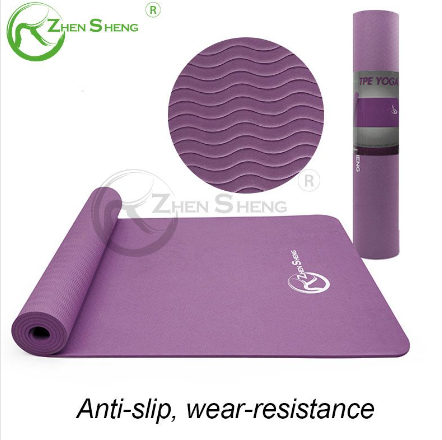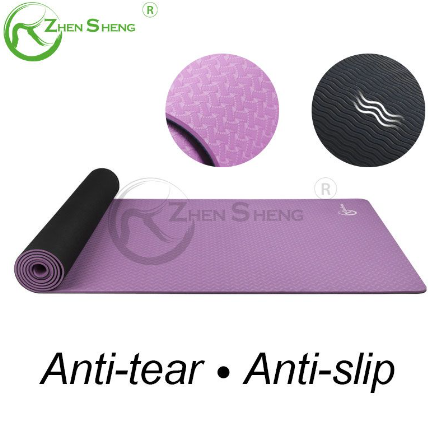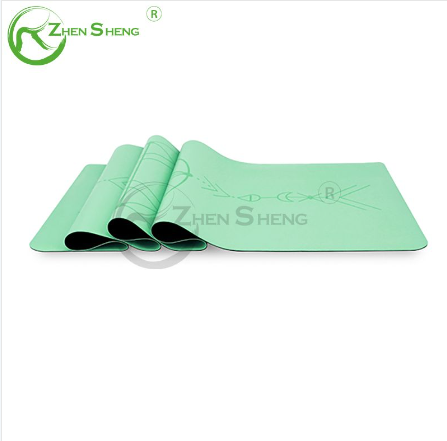Best Yoga Mats Buying Guide - ZHENSHENG
If you have any product customization needs or ideas, MOQ 500, contact us.
Aug. 20, 2022
For yogis, there is more than one option and more than one style of yoga. Yoga mats also come in a wide variety of materials, sizes and thicknesses.
Our article will cover these and more and should make the decision-making process a little easier.
As you read this article, please be aware of the style of yoga you practice. The mat you choose should reflect this experience. If you are new to yoga, you should focus more on a basic entry level mat. If you change or move to a new form of yoga, your mat will need to change too.
The differences in materials may seem simple at first glance, but they are very important when practicing yoga. The mat and your practice need to feel balanced. Before looking for a specific type of material, consider each of these options thoroughly.
PVC: This is the most popular yoga mat and is available in yoga studios all over the world. A perfect entry-level mat, this basic yoga mat is made from polyvinyl chloride (PVC). This material offers good durability, adhesion, and comfort. The PVC mats are designed with large openings to give them a plush softness, PVC is a plastic-based material that is very durable, easy to clean, and provides excellent floor grip. However, PVC mats do not absorb water and can become slippery when you sweat a lot. PVC is latex free, which is good for people with latex allergies, however, it is not as biodegradable or environmentally friendly as other options.
TPE Foam: An environmentally friendly version of the PVC mat, the foam yoga mat has the same performance characteristics but with the feel and grip of rubber. TPE (thermoplastic elastomer) mats are a denser material with a thinner thickness of about 3 mm to 5 mm. These mats work better in humid climates or hot yoga styles. TPE mats are usually less durable than PVC mats of the same thickness but still provide good traction.
Rubber: Popular among eco-friendly yoga mats, rubber yoga mats are a sturdier alternative to foam TPE mats. Rubber mats contain latex. This mat works better in humid climates or hot yoga styles, the only downside is the smell. PU is non-absorbent and easy to clean, and it is also 100% vegan. pu has antibacterial properties and is virtually non-slip, making it an excellent choice for strenuous forms of yoga such as hot yoga or ashtanga. PU is also very tough and highly abrasion resistant; making it very durable and ideal for yoga mats that are used regularly.
Cotton: These are the traditional yoga mats, cotton mats are both thin and environmentally friendly. They are also commonly used on other yoga mats to provide support. Cotton absorbs sweat very well and actually increases grip when wet. As a type of eco-mat, they have slightly less grip on the floor, but their natural texture provides traction for your body. Eco-mats lack the decade-long durability of PVC, but if sustainability is your priority, they come out on top.
Jute: Similar to TPE and rubber yoga mats, they are usually made from TPE or rubber backing. Jute offers the same sustainability and resilience. Jute yoga mats have excellent traction and excellent support. However, jute is a more fibrous material and is a little rough, but will provide a good grip when wet. As an alternative to eco-mats, they have slightly less grip on the floor, but their natural texture provides traction for your body. Eco mats lack the decade-long durability of PVC, but if sustainability is your priority, they come out on top.
Yoga mats include slim and compact travel styles weighing just 2 lbs. to an easy quarter inch beast weighing up to 7 lbs.
If you're not sure where to start, choose a mat that is approximately 1/8 in. thick (or 3.175 mm), a fairly standard thickness. These mats are perfect for those who perform strong, fluid exercises. They allow firm contact with the floor, which helps maintain stability in a variety of postures. They are also less likely to grab and get in your way as you move from pose to pose than thicker mats.
Thinner mats can help add stability to yoga styles that have a more active pose or a balanced, focused pose. Look for mats with a textured surface to maintain a better grip as the pose becomes more strenuous.
Thicker mats Provide extra cushioning and are best suited to more therapeutic practices. For example, if you enjoy restorative yoga (a type of yoga with fewer poses but longer holds), you may prefer a softer, more cushioned mat. Thicker mats are also more comfortable for yogis in forearm and kneeling poses and for those with soft knees or aching joints. However, they may be more difficult to balance during standing poses.
If your yoga program includes air travel, look for a travel mat that is designed for portability. Travel mats are very thin and light and smaller than traditional mats, so they are easy to carry in your luggage. Keep in mind that travel mats sacrifice some cushioning.
There are many different kinds, but the three main sizes are ¼=6mm, 1/8=4mm and 1/16=2mm. the difference between the three is quite significant. If a yoga mat is too thin, certain poses may cause damage to your knees and joints. If the mat is too thick, it will be difficult to maintain balance and hold the poses. Take a look at the advantages and disadvantages of each thickness.
3/8" = 8mm thickness: Generally speaking, the thickest mats are 3/8 or 8mm". High-end, quality mats are usually this size to provide optimum comfort and support. However, with the added cushioning, the added weight of approximately 8 lbs. will make the mat less portable.
¼" = 6mm thickness: ¼ or 6mm mats are the most commonly used today, this size is used in most yoga studios and is usually the best in terms of comfort and support. The mat is the perfect size to fit into any standard yoga bag.
1/8" = 4mm thickness: This is the most common thickness used in Pilates and is no longer commonly used in yoga.
1/16" = 2mm thickness: Considered a travel mat. If you are constantly on the go, you should consider this an ultra-portable solution. 1/16" = 2mm mat fits into any yoga mat bag or suitcase with room to spare.
The standard yoga mat is 24" x 68" but the length and width can vary, the width usually stays 24" but can be as wide as 28" and the length can be as long as 72" and 74" but a few mats are up to 84" long. While most yogis will fit on a standard size mat (24" x 68"), taller yogis may need a slightly longer mat.
Texture
Similar to stickiness, the texture of your yoga mat can help you maintain balance and proper alignment. Rubber or jute yoga mats add grip through the raised texture, which helps keep poses firm no matter how sweaty you are. For smoothness and extra comfort, a PVC mat is your best choice. Please note that these mats may not provide sufficient grip when wet.
The texture of a yoga mat determines the traction it provides. Like stickiness, texture affects how much you slide. It provides a physical barrier to sliding (whereas stickiness relies on suction). And because texture affects the feel of your yoga mat, it is also a component of overall comfort.
If you are the pea princess type, any uneven texture may exacerbate your mood in savasana. Textures can be artificial (such as a raised bump pattern) or determined by the material - jute yoga mats have an organic, rough feel, while PVC mats have a slight texture but a softer feel. Yoga mats can range from completely smooth to completely rough.

Stickiness is a measure of how well your feet stick to the mat, helping you to hold your posture and maintain proper alignment. PVC and foam mats have the highest stickiness factor when dry, while rubber and jute have a moderate amount, but will hold better when wet. Cotton yoga mats have little to no stickiness.

One of the main factors that will help you decide on the right yoga mat is the type of yoga you plan to practice. If you are new to the world of yoga, a basic yoga mat will work well at first. However, if you already have a few favorites, they should play an important role in helping you decide on your next yoga mat.
Remember the style of yoga you practice and the props you might use, from sticky gloves and socks to chairs; everything affects a yoga mat. Some yoga mats (such as PVC) can be easily damaged by these types of props.
As yogis, the tenets of ahimsa or non-violence are often cherished. This has made practising on a yoga mat that ends up clogging up landfills a hassle for decades. Eco-friendly yoga mats are usually made from natural or recycled rubber. These yoga mats may also include natural materials, such as jute or organic cotton.

Typically, a basic 1/8-inch thick, solid-colored PVC sticky yoga mat will be at the lower end of the price range. From there you can pay more for patterns, designs or logos; premium thickness; anti-bacterial treatments; and cool textures, especially raised tactile patterns. Eco-friendly yoga mats tend to be at the top end of the price range.
Search Blog
New Products
E-mail: planning@shzhensheng.com
Mob.: +86 138 0168 6978
Tel.: +86 21 5204 8758
Add.: Room 203, Building 1, No. 423 Wuning Road, Putuo district, Shanghai 200063, China
Navigation
Get in touch
seoKeywords: custom size yoga mat custom logo yoga mat custom Rubber Pilates Yoga Mat eco friendly rubber yoga mat custom Pilates Yoga Mat TPE Rubber Professional Yoga Mat rectangle yoga mat tpe comfortable tpe yoga mat comfortable tpe yoga mat Customize nbr yoga mat custom round yoga mat round yoga mats wholesale eco friendly yoga mats wholesale non slip yoga mat wholesale Customize non slip yoga mat wholesale ankle weights wholesale custom round yoga mat round yoga mats wholesale personalized soccer ball size 5 personalized soccer ball size 4 Thermo Bonded Football Machine Stitched Football custom resistance bands wholesale wholesale resistance bands with logo custom printed resistance bands custom logo resistance bands custom size resistance bands custom length resistance bands custom ankle weights ankle weights cost ankle weights cost buy ankle weights custom balance board surf balance board oem yoga mat yoga mat factory yoga mat manufacturer tpe yoga mat manufacturer private label yoga mats